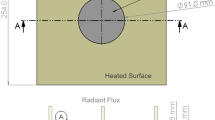Conclusions
We propose an approach to evaluating the thermal-shock resistance of solid bodies in a thermal-shock schedule based on the development of elastic waves of compression (expansion) and the final value of the velocity of the thermal waves.
A model is put forward and also a calculation equation for the destructive drop in temperature ΔTp in the thermal-shock schedule.
The magnitude characterizing the dissipation of energy during thermal loading equals the ratio of the velocities of the thermal and longitudinal sonic waves in the solid body.
During thermal loading of the solid body over the entire external surface it is necessary to take into account the superpositioning of the waves, and the possibility of the sudden increase in the stress on the wave front to a value exceeding the tensile strength of the material, with significantly lower temperature gradients.
The calculation equation obtained for determining the destructive temperature limit agrees qualitatively with the known experimental data, and enables us to predict the thermalshock resistance of the traditional refractories, and to determine means of creating new material resistant to thermal shock.
Similar content being viewed by others
Literature cited
K. K. Strelov, Structure and Properties of Refractories [in Russian], Metallurgiya, Moscow (1982).
W. D. Kingery, Introduction to Ceramics [in Russian], Stroiizdat, Moscow (1964).
D. P. H. Hasselman, Bull. Am. Ceram. Soc.,49, No. 12, 100 (1970).
V. Daukinis, K. Kazakyavichyus, G. Prantskyavichyus, and V. Yurenas. Investigation of the Thermal-Shock Resistance of Refractories [in Russian], Mintis, Vilnius (1971), p. 151.
A. V. Lykov, Theory of Thermal Conductivity [in Russian], Vysshaya Shkola, Moscow (1967).
S. P. Timoshenko and J. P. Gud'er, Theory of Elasticity [in Russian], Nauka, Moscow (1979).
A. F. Koryshev and G. A. Frolov, Use of Sun and Other Sources of Energy in Material Physics [in Russian], Naukova Dumka, Kiev, (1983), pp. 137–145.
Additional information
This article is published in the nature of a discussion
Translated from Ogneupory, No. 5, pp. 13–15, May, 1988.
Rights and permissions
About this article
Cite this article
Kolomeitsev, V.V., Dergunov, K.N. Thermal-shock resistant refractories and ceramics under thermal-shock conditions. Refractories 29, 280–283 (1988). https://doi.org/10.1007/BF01293363
Issue Date:
DOI: https://doi.org/10.1007/BF01293363



